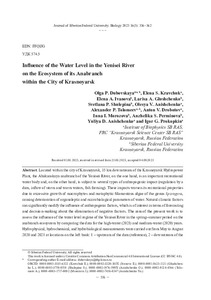Влияние уровня воды в реке Енисей на экосистему его протоки в черте г. Красноярска
Автор:
Дубовская, О. П.
Кравчук, Е. С.
Иванова, Е. А.
Глущенко, Л. А.
Шулепина, С. П.
Анищенко, О. В.
Толомеев, А. П.
Дроботов, А. В.
Морозова, И. И.
Перминова, А. С.
Анищенко, Ю. Д.
Прокопкин, И. Г.
Dubovskaya, Olga P.
Kravchuk, Elena S.
Ivanova, Elena A.
Glushchenko, Larisa A.
Shulepina, Svetlana P.
Anishchenko, Olesya V.
Tolomeev, Alexander P.
Drobotov, Anton V.
Morozova, Inna I.
Perminova, Anzhelika S.
Anishchenko, Yuliya D.
Prokopkin, Igor G.
Дата:
2023-09Журнал:
Журнал Сибирского федерального университета.Биология. Journal of Siberian Federal University.Biology, 2023 16 (3)Аннотация:
Расположенная в черте города Красноярска в 35 км ниже Красноярской ГЭС
Абаканская протока р. Енисей является, с одной стороны, важным рекреационным водоемом,
а с другой стороны, подвержена нескольким типам антропогенного воздействия (зарегулирование
дамбой, поступление ливневых и теплых вод, наличие садкового рыбоводного хозяйства),
ухудшающего ее рекреационные свойства
из-за
чрезмерного зарастания макрофитами
и скоплений метафитона нитчатой водоросли рода Spirogyra, ухудшения органолептических
и микробиологических показателей воды. Природные климатические факторы способны
существенно модифицировать влияние антропогенных факторов, что представляет интерес
в плане прогнозирования и принятия решений по ликвидации негативных явлений. Целью
работы является оценка влияния режима уровня воды р. Енисей в весенне-летний
период
на экосистему протоки через сравнение данных в многоводный (2021) и средневодный (2020)
годы. Гидрофизические, гидрохимические и гидробиологические измерения проводили
с мая по август 2020 и 2021 гг. сверху вниз на станциях левобережья: 1 – выше дамбы (фон),
2 – ниже дамбы, 3 – напротив выпуска теплых вод ТЭЦ, 4 – пляж, ниже рыбоводных садков.
В 2021 г. вода в протоку поступала только снизу (к ст. 4 и 3), так как водопропускные трубы
в теле плотины были засыпаны. В 2021 г., по сравнению с 2020 г., на зарегулированном участке
протоки значительно увеличились численность и биомасса фито- и зоопланктона, возросла
первичная продукция планктона, а аналогичные показатели фитоперифитона и зообентоса,
напротив, снизились по причине их формирования на свежезалитых грунтах. Метафитон
отсутствовал, но в августе спирогира стала доминировать в биомассе фитоперифитона.
Концентрации нитрит-иона
в воде увеличились в зарегулированной части протоки, а нитрат-иона
и общего фосфора – на всех станциях протоки, в том числе и на фоновой, получающей воды
из Красноярского водохранилища. Наблюдаемая в 2021 г. «вспышка трофии» в планктоне ст. 3
и 4 обусловлена длительным (полтора месяца) удержанием высокого уровня воды в протоке,
позволившим использовать биоте вымываемые из затопленных берегов органические вещества
и биогены, и аналогична таковой в экотонных зонах выклинивания подпора водохранилищ.
Ежегодное увеличение концентраций минеральных форм азота и общего фосфора на нижних
станциях, по сравнению с другими станциями, вероятно, обусловлено эвтрофирующим
влиянием садкового рыбоводного хозяйства Located within the city of Krasnoyarsk, 35 km downstream of the Krasnoyarsk Hydropower Plant, the Abakanskaya anabranch of the Yenisei River, on the one hand, is an important recreational water body and, on the other hand, is subject to several types of anthropogenic impact (regulation by a dam, inflow of storm and warm waters, fish farming). These impacts worsen its recreational properties due to excessive growth of macrophytes and metaphytic filamentous algae of the genus Spirogyra, causing deterioration of organoleptic and microbiological parameters of water. Natural climatic factors can significantly modify the influence of anthropogenic factors, which is of interest in terms of forecasting and decision-making about the elimination of negative factors. The aim of the present work is to assess the influence of the water level regime of the Yenisei River in the spring–summer period on the anabranch ecosystem by comparing the data for the high-water (2021) and medium-water (2020) years. Hydrophysical, hydrochemical, and hydrobiological measurements were carried out from May to August 2020 and 2021 at locations on the left bank: 1 – upstream of the dam (reference), 2 – downstream of the dam, 3 – opposite the outlet of warm water, 4 – at the beach, downstream of the fish farm. In 2021, water
entered the anabranch only from downstream (to locations 4 and 3), since the culverts in the dam body
were filled up. In 2021, compared to 2020, the abundance and biomass of phyto- and zooplankton in the
regulated section of the anabranch significantly increased, the primary production of plankton increased,
but the corresponding parameters of phytoperiphyton and zoobenthos, on the contrary, decreased due
to their formation on freshly flooded soils. Metaphyton was absent, but in August, Spirogyra began
to dominate in the phytoperiphyton biomass. Nitrite ion concentrations in the water increased in the
regulated part of the anabranch, and the nitrate ion and total phosphorus concentrations increased at
all locations, including the reference location, receiving water from the Krasnoyarsk Reservoir. The
plankton “abundance outbreak” observed in 2021 at locations 3 and 4 was caused by the water level in
the anabranch remaining high over a long period (one and a half months), which made it possible for the
biota to use organic matter and nutrients washed out from the flooded banks; the outbreak was similar
to those occurring in the ecotone zones of inputs to the upper parts of reservoirs. The annual increase
in the concentrations of mineral forms of nitrogen and total phosphorus at the lower locations compared
with other locations was probably due to the eutrophic influence of fish farming

